Box 28, Arenas Valley, NM — A tiny country post office played a big role in my youth (Part 1)
In 1949, when I was six years old, I was transplanted (along with my parents and my sister, who was 11) from our tiny, civilized village of Savona in New York State to the tiny, less-civilized village of Arenas Valley in rural Southwestern New Mexico, six miles east of Silver City, the largest of several communities in the region.

Dad would become the editor of the weekly Silver City Enterprise, which had begun publishing news about gunfights, fabulous gold and silver mines, and Apache attacks in 1882. For Mom, Arenas Valley was no Southwestern Shangri-La: she would continue to be a housewife, coping with more dust and weeds, fewer flowers, and less grass and water than she could ever have imagined. We had even less water after the Robinsons, immediately to the east, drilled a deep well that produced a gusher of water. They planted, and frequently watered, a large ornamental garden. When they watered it, which they did frequently, our shallow well would only suck air. The Robinsons ignored our request to save a bit of water for us. They were such good Baptists!
Our small, poorly insulated house, rented from my paternal grandparents, was barely large enough for a family of four; dad built a wall out of plywood and 2X4s to create separate, very small bedrooms for Helen and me. We would live there until 1957, and then move to Silver City so my grandparents could move into it when Grandpa Ingraham retired from his job as a machinist at the Kennecott Copper Corporation smelter at Hurley, a company-owned town about seven miles southeast of Arenas Valley.
In the 1950s, Arenas Valley’s population numbered perhaps 300 residents.The Arenas Valley Road had once linked Silver City with nearby Fort Bayard and other towns in the mining district — Central (changed to Santa Clara in 1996), Bayard, Santa Rita, North Hurley, and Hurley — and a scattering of smaller communities — Vanadium, Hanover, and Fierro. By 1949, a new highway, U.S. 180, bypassed Arenas Valley and Fort Bayard. However, as small as Arenas Valley was, it had a post office!
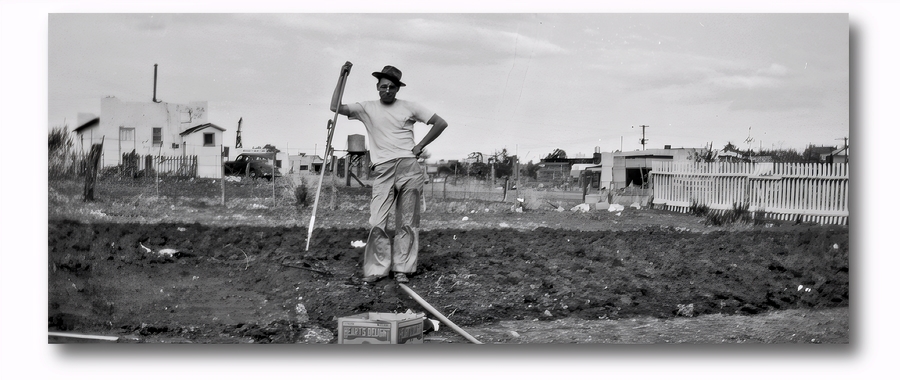
Had we moved to Arenas Valley, or Whiskey Creek?
Within a few days of our arrival in Arenas Valley, we learned that…
• Many of its residents called the village Whiskey Creek.
• The large arroyo (a normally dry gully or draw in Southwestern parlance, often mis-pronounced arroyah that wound its way across Arenas Valley/Whiskey Creek was itself called Whiskey Creek.
According to local legend, at some point early in the community’s history heavy rain in the Piños Altos Range, a few miles north in the Gila National Forest, flooded an illegal still and sent whiskey barrels floating down the arroyo, which came to be called Whiskey Creek.
A more likely story, told by an amateur historian Dorothy Watson in her book Piños Altos Story, tells how a young man went to El Paso to buy a barrel of whiskey:
All went well on his way back until he reached the creek east of camp Piños Altos1 where he had a breakdown. He managed to get word in and the boys went down the trail with their tin cups. Nest said that he netted about $800.00 in cash and gold.
Miss Watson goes on to explain how the village of Whiskey Creek became Arenas Valley:
Many years later the good people ranching down the valley petitioned the legislature to have the name changed. The bill was introduced by the senator from this district. Some wag suggested “Cedarbrook,” that being the senator’s favorite brand [of whiskey]. The name was changed to Arenas Valley but the people at this end prefer “Whiskey” to “Arenas” (sand).
New Mexico State Historian Rob Martinez mostly confirmed Miss Watson’s account. At its beginnings, he noted in an email, Arenas Valley was the namesake of the Rio de Arenas, another arroyo about a mile southwest of my family’s house. In the 1880s, he wrote, the village was called Whiskey Creek, but at some unknown later date locals wanted the name changed back to Arenas, and an act of the legislature secured the name.
Why?
So why did Whiskey Creek’s residents want to dump Whiskey Creek and embrace Arenas Valley? The fraught history of alcohol in America may be a clue.
The Eighteenth Amendment to the United States Constitution established the prohibition of alcohol in the United States. 1919, and capital “P” Prohibition was proclaimed as a federal law 1919. But a federal law was too blunt an instrument to affect change in America’s beverage preferences.
Whiskey and other alcohol was never considered to be “the devil’s brew” by everyone. This 1893 cover2 shows that the whiskey was bread and butter for the Frank E.S. Harvey company of Buffalo, which posted this cover to a bank in Silver Creek, New York.

For the nearly 14 years that Prohibition was the law of the land, criminals made fortunes by smuggling “tax-free” alcohol from “wet” countries like Canada and opening “speakeasies” where people could buy alcohol, gamble, eat, and enjoy cabaret-style entertainment. Some drinkers became blind or even died after drinking spirits adulterated with dangerous forms of alcohol. Criminal organizations like the Mafia grew richer and more powerful by selling illegal booze to anyone who wanted it, regardless of their station in life. Physicians got an exemption from the law, and were able to prescribe (and sell) “medicinal whiskey” at a profit. Police resources were stretched to the limit, especially when “dirty cops” confiscated illegal booze and then sold it on the black market. At the same time, health problems associated with excessive alcohol consumption became less common, and crime rates generally dropped, although homocides increased.
The 18th Amendment was finally repealed in December, 1933, the only Constitutional amendment ever to be repealed. The experiment had taught adult Americans that excessive alcohol consumption could lead to perdition, government oversight, or worse. Teetotalers became even more certain that booze wasn’t just a problem, but the problem.
Did Prohibition ultimately lead to the legislative seal of approval of the name Arenas Valley? Perhaps the residents of Arenas Valley didn’t want their their community and the cancellations on their letters to raise apparent toasts to John Barleycorn!
Whiskey Creek was no creek
Regardless of the origin of its name, to call Whiskey Creek a creek has been wide of the mark for decades. It might once have been a “permanent” creek, but in the 1950s it ran with water only during the spring and summer Southwest Monsoons, when flash floods transported tons of New Mexico soil southward toward Mexico, some 70 miles to the south. Whiskey Creek was only 300 feet behind our house. When it was in flood, we coould hear it roar. About 1,100 feet to the southwest it crossed Arenas Valley Road. The road, designed to accommodate Whiskey Creek’s floods, dipped low where the water crossed the road. It was great fun to drive through the dip: going down, you felt almost weightless and tended to rise from the car seat; at the bottom and going you back up to the straightaway, you felt much heavier and were forced down into the seat. The same sensations are common in flight, especially in small, highly maneuverable aircraft.
Whiskey Creek is, or at least was, a defining geological feature of the area. In flood, it was challenged only by drivers who were utter fools or world-class optimists. The force of its torrent could easily have carried away a car or pick-up.
It’s no monster now…
Whiskey Creek the arroyo is no longer the formidable monster it was in the 1950s (and for decades before, presumably). Today, Google’s Street View shows it as little more than a drainage ditch that has drained very little in recent years, perhaps because of the longstanding drought in the American Southwest. The dip in Arenas Valley Road has been replaced by a culvert.

The Rio de Arenas
The choice of Arenas Valley over Whiskey Creek for the name of the village seems reasonably clear, but begs a question: Why Arenas Valley? What was the source of the Arenas in its name? Interestingly, Arenas Valley may be the namesake of another arroyo which carries runoff from the Piños Altos Range. It’s the Rio de Arenas, which passes through a culvert beneath Arenas Valley Road about a mile southwest of my family’s house. I discovered Rio de Arenas only in 2025 when I was “exploring” Arenas Valley by way of Google’s useful Street View service. Although my family lived in Arenas Valley from 1949 until 1957, and I had ridden over the Rio de Arenas thousands of times in my school bus and in my family’s car, I don’t recall ever noticing it. There was no dip in the road to accommodate its floods, assuming that there were floods. Today it seems like it can never have been more than a bernign, north to south depression in the slightly rolling landscape.
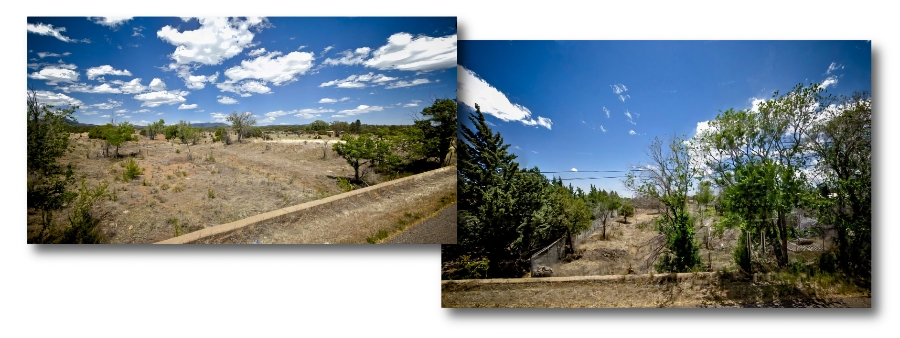
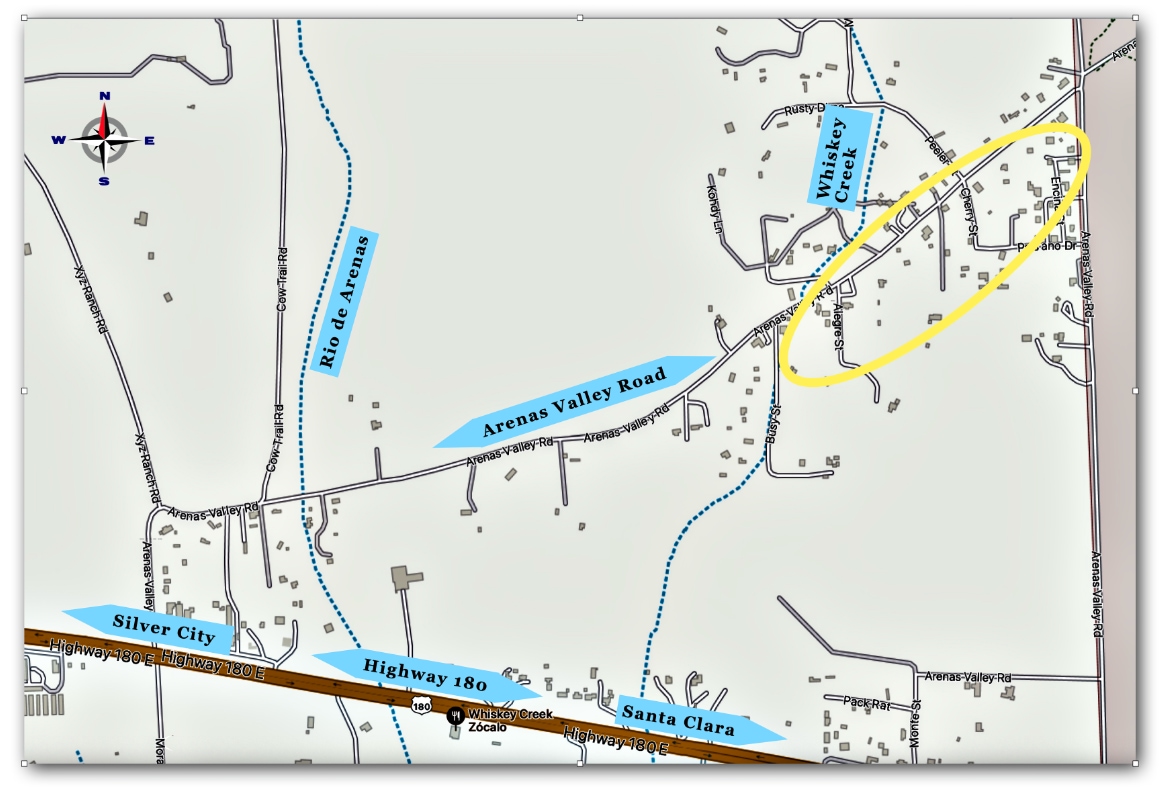
Olga Harper requests a post office (but she wasn’t the first)
Sometime during the Second World War, a woman named Nantie L. Brown was authorized to open a post office in Arenas Valley, but on December 20, 1944, her appointment was rescinded. The reason is not known.
In 1946, Olga Mae Harper, who happened to be the mother of the boy who would become my best friend, Ernest, applied for the opening of a post office in Arenas Valley, with herself to serve as postmaster. Her application clearly assumes that the post office would be the Arenas Valley Post Office:
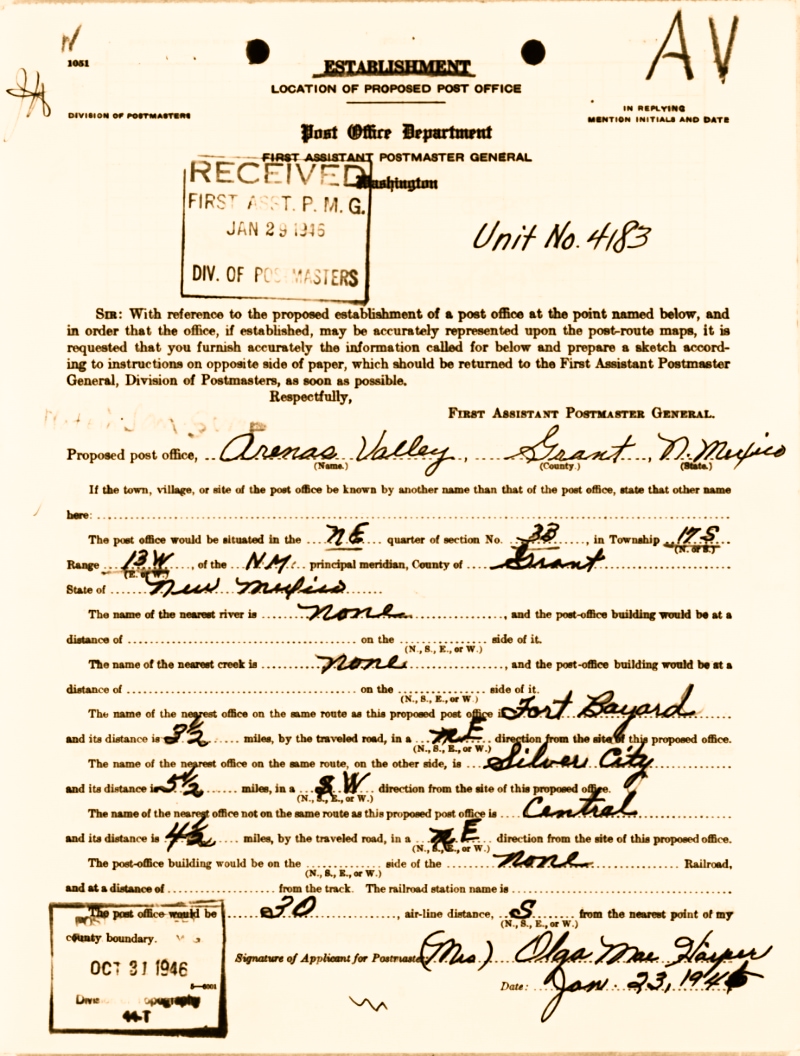
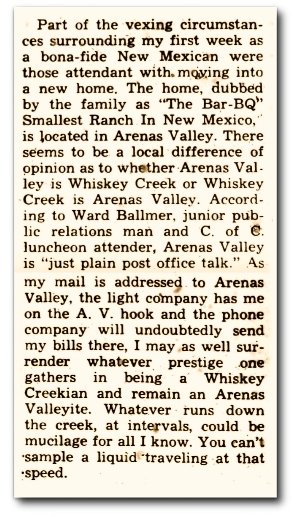
Whatever the reason for choosing the name Arenas Valley for its post office rather than Whiskey Creek, even residents of the village weren’t clear about its “real” name. The community’s dual identity became the subject of one of my dad’s tongue-in-cheek Enterprise columns, This World Of Mine, published in August, 1950 and reproduced at the right.
Why did Arenas Valley even have a post office?
While the choice of Arenas Valley for the name of the post office is more or less clear, one other mystery remains. Kelvin Kendahl, a member of the Post Mark Collectors Club, wrote in an email:
I was surprised that a new office was opened as late as 1946. The total number of post offices in this country has been going down since about 1901, when there were about three times as many as there are now. As rural free delivery started to become widespread, it replaced a LOT of post offices. Of course, I also see things from a New England perspective, where things were a lot different. Very few post offices opened after 1901 in this part of the country.
Even if most Arenas Valley folks could easily travel to Silver City, I think in 1946, it was still seen as important to provide services to the residents there, as opposed to today, when it's assumed that everybody goes to Silver City often enough that services aren't necessary in Arenas Valley. That may have contributed to it, but doesn't explain why the post office didn't open 20 or 40 years earlier than it did.
On December 13, 1946 Arenas Valley, Mrs. Olga Harper was named postmaster:3

The post office, located in a small, new addition to the Harper’s ramshackle home, opened for business on January 1, 1947, adjacent to the Harper’s former living room, which had been turned into a small convenience store. I recall the store, but not the post office as it was then.

Mrs. Harper’s job required more than selling postage stamps, postal savings stamps, and money orders, as well as distributing mail to the mailboxes, weighing parcels, etc. She had to submit regular reports to the Post Office Department. The cover shown below illustrates her submission of one such report:

-
The pioneer gold- and silver-mining community of Piños Altos is located high in the Piños Altos Range about five miles north-northwest west of Arenas Valley. ↩︎
-
A cover is the name that philatelists give to envelopes, particularly envelopes that have moved through the mail stream. The stamps, cancellation, addresses, and various postal markings often provide significant information about the senders, recipients, time and route of transit, and even evidence of delays caused by crashes, fires, political unrest, wars, and storms. Enclosed letters sometimes include information — philatelic gold! — that is missing in history books or TV documentaries. ↩︎
-
The term postmaster is gender neutral; Postmistress and postmaster have been used interchangeably since Mary Katherine Goddard served as Baltimore’s postmaster from 1775-1789. She was the only female postmaster when Benjamin Franklin was named the first American Postmaster General in 1775, making her the first known postmaster / postmistress in the United Colonies, predecessor of the United States. ↩︎